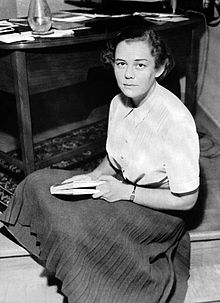Ulla Isaksson
Ulla Isaksson | |
|---|---|
 Ulla Isaksson | |
| Born | June 22, 1916 Stockholm, Sweden |
| Died | April 24, 2000 (aged 83) Stockholm, Sweden |
| Occupation | Writer |
| Language | Swedish |
| Nationality | Swedish |
| Citizenship | Sweden |
Ulla Isaksson (22 June 1916 – 24 April 2000) was a Swedish author and screenplay writer. She was born and died in Stockholm, Sweden. In addition to her short stories and novels, Isaksson also wrote scripts for films and plays.
Early life and education
Isaksson was born in Stockholm in 1916, the daughter of
Career
In 1940 Isaksson debuted with the novel
Several of Isaksson's novels of the 1950s are marked by religious problems, as ultimately in Havet and Dit du icke vill, where 17th century witchcraft trials in a village in Dalarna are portrayed of the bases of contemporary protocols. In her previous books she had written primarily about religious tensions and conflicts. In later novels she also directed analysis against erotic motifs, world problems, women's issues, and parenting.[3]
Isaksson remained married to David Isaksson until 1963, when she married secondly the author Erik Hjalmar Linder. Together with Linder, she wrote a two-part biography of the author and journalist Elin Wägner called Elin Wagner, amazon with two breasts, 1882-1922 (Bonnier, 1977) and Elin Wagner, daughter of Mother Earth, 1922-1949 (Bonnier, 1980).
In 1994, Ulla Isaksson's autobiography Boken om E was published. This is largely about how she saw her husband Erik Hjalmar Linder suffering from Alzheimer's disease. Boken om E was adapted for the screen in 2001, directed by Bille August, and entitled A Song for Martin.
Isaksson died on 24 April 2000, before the adaptation of Boken om E.
De två saliga (The two blessed), 1962
The book portrays a couple whose love, in combination with psychosis and religious blindness, causes them to go under. The frame story, about a psychiatrist who reads journals concerning this "case", is following another marriage. The book's core question is what actually determines if a relationship based on love is healthy or sick. It is a classic case description, created using hospital records, letters, and recollections.[4] De två saliga was made into a movie by Ingmar Bergman, and released in 1986.
Kvinnohuset (The women's house), 1952
Kvinnohuset is about a shared housing unit for single working women. A chain of human destinies that cross and touch each other, and where the common denominator is that they are all women living in the same house. A special house for single self-sufficient women, with a doorman for help. The topic of the day is the young theater student Eva Lind, who is about to move in. Most tenants know she is the theater decorator Trygve Krook's mistress. Krook has got an apartment for her in the house, where his wife Anna also lives. The other women living in the house have a hard time understanding her toleration and her indifference to the husband's doings.[5] Kvinnohuset was made into a movie in 1953 and was the first of Ulla Isaksson's novels that was adapted.
Paradistorg (Paradise square), 1973
Paradistorg is the name of a summerhouse in
Boken om E (The book about E), 1994
Ulla Isakssons autobiographical account of how her husband Erik Hjalmar Linder suffered from
Bibliography
- Trädet (1940)
- I denna natt (1942)
- Av krukmakarens hand (1945)
- Ytterst i havet (1950)
- Kvinnohuset(1952)
- Dödens faster (fiction, 1954)
- Dit du icke vill (1956)
- Klänningen(1959)
- De två saliga (1962)
- Våra torsdagar (play) (1964)
- Klockan (1966)
- Amanda eller den blå spårvagnen (1969)
- Paradistorg(1973)
- Elin Wägner del 1, together with Erik Hjalmar Linder (1977)
- Elin Wägner del 2, together with Erik Hjalmar Linder (1980)
- Födelsedagen (1988)
- Boken om E (1994)
Filmography
- 1953 – Kvinnohuset (Script)
- 1958 – Nära livet(Script)
- 1960 – Jungfrukällan(Script)
- 1983 – Här har ni hans liv! (TV-show)
- 1988 – Hjalmar och Stina (TV-show)
- 1993 – Chefen fru Ingeborg (TV-show)
Awards
- Svenska Dagbladets litteraturpris (1952)
- Member of Samfundet De Nio (1973)
- Member of Kungliga Vetenskaps- och Vitterhetssamhället i Göteborg (1977)
- Hedersdoktor in Stockholm (1978)
- Göteborgs-Postens litteraturpris (1988)
- Stiftelsen Selma Lagerlöfs litteraturpris (1995)
- Samfundet De Nios Särskilda pris (1999)
References
- ^ "Nordisk Kvinnolitteratur". Larsson, Lisbeth. Retrieved 2014-03-24.
- ^ "Ingmar Bergman". Holmgren, Jan. Retrieved 2014-03-24.
- ^ "Albert Bonniers Förlag". Wägner, Elin. Retrieved 2014-03-24.
- ^ "Adlibris". Hallberg, Anna. Retrieved 2014-03-24.
- ^ "Svensk Filmdatabas". Kvinnohuset. Retrieved 2014-03-24.
Further reading
External links
- Ulla Isaksson at IMDb
